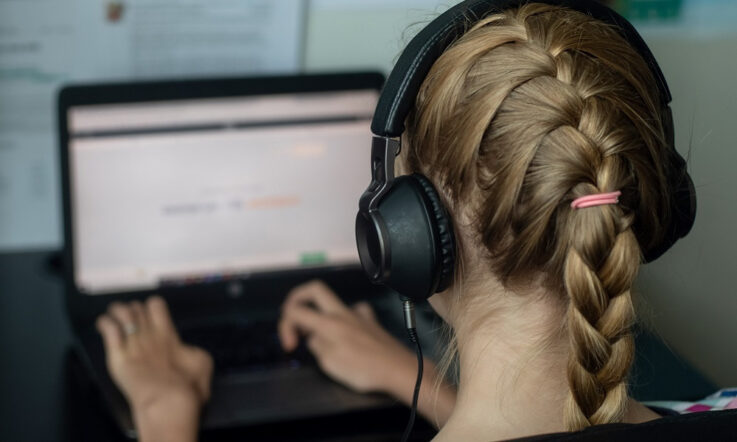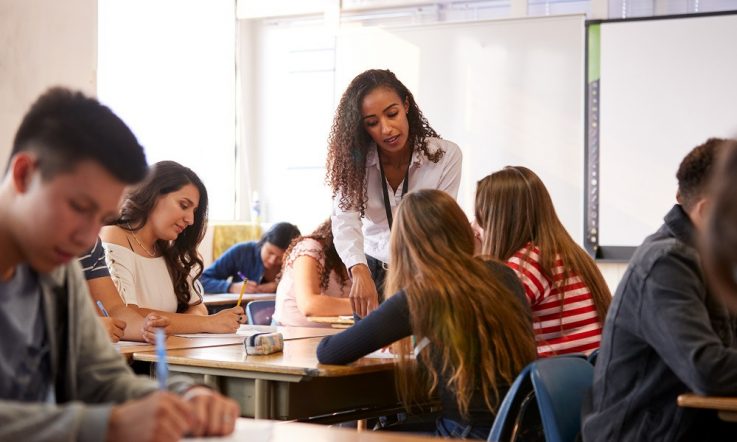It's no secret that 2020's unexpected juncture with COVID-19 has triggered many challenges for schools and communities, with few impacted more than the students themselves.
When Upper Yarra Secondary College, in Victoria, first went into lockdown and transitioned to the online learning space in late March, we made some hasty decisions about our students and how they would best learn. We crossed our fingers that these would work.
Assumptions were made as to our students' ability to work independently, the use of Google Classroom as the mandated IT platform and the teacher's role in delivering the curriculum. During remote learning 1.0, we surveyed our students asking them to report back their experiences to us. Of our 550 students, 372 responded across all year levels (7-12). We then worked with La Trobe University to analyse the data, further developing an existing partnership we have with them under their Nexus program. Nexus, supported by the Federal Government's High Achieving Teachers Program, is a first of its kind pathway into secondary teaching. We used this relationship to support our research so that the pedagogical mistakes from March weren't reproduced when COVID-19-induced online learning started up again in July.
While it will take us some time before we understand the full effect of temporary school closures on student learning long term, we've (in the meantime) learnt some important things to inform our teaching practices going forward. Here's a taste of what our students told us.
‘We don't like being online this much'
It's stressing with all the work we have to complete (Kori, 15).
Initially, in Remote Learning1.0, we were worried about our students falling behind. Our school has an ICSEA (Index of Community Socio-Educational Advantage) of 956, with 53 per cent of students in the bottom quarter of socio-educational advantage. Early indications from global studies suggest that it's students from disadvantaged backgrounds who will suffer disproportionately from the educational impacts of COVID-19 (Robson, 2020). The Grattan Institute's report (Sonnemann & Goss, 2020) on ‘COVID catch-up' predicts a further widening of the attainment gap between richer and poorer families. So, according to the report, even if remote learning works well for our school, our disadvantaged students are likely to have learnt at about 50 per cent of their regular rate, losing about a month of learning over a two-month lockdown.
Our hurried response in acknowledging this concern was to set up learning programs during the first lockdown that had the potential to be ‘glorified homework' for students. Teachers amended their planners to account for some of the challenges of delivering work remotely, subsequently removing chunks from these plans. They converted much of their hard copy work into soft copies. They swotted up on Google Classroom and Screencastify (a Chrome extension for screen video recording and subsequent editing). They reinvented the wheel in an attempt to ensure our students were not further disadvantaged.
In the rush to get the online platform up and running, we forgot that students don't like homework all that much. Delivering the entire curriculum as homework created real challenges for us, and the students.
Data from our initial survey, conducted three weeks into the first remote learning period, told us that 55 per cent of our students thought we were giving them too much work.
I have found it challenging to understand the work (Bridie, 15).
Figuring out the work, understanding instructions (Stuart, 12).
So, in Remote Learning 2.0, we consciously reduced the workload to 50 per cent of what would be expected normally in a face-to-face environment. Surprisingly, 43 per cent of students still thought it was too much in the second survey.
Further conversations with students uncovered the belief that there was actually not too much work, but that were finding it too difficult to complete it on their own. Numerous comments from students stated that not having the teacher there to help one-on-one, as would happen in the real-life classroom, was one of the greatest challenges for them.
‘We miss being with our teachers'
It was no surprise to us that 70 per cent of our students reported a preference for face-to-face teaching over remote learning. What did surprise us, though, was how much the taken-for-granted nuances of the teacher-student relationship impacted students' ability to engage with their online material.
They missed their teachers checking in with them, looking over their shoulders to see if they understood what they were learning. We underestimated the reliance students have on the constant reminders that teachers provide each lesson – such as, ‘Remember your essay is due on Friday'. Even though these reminders were probably posted online with the task and appeared in Google Classroom, many students, across all year levels, felt we did a poor job of providing them with clear dates for the completion of work.
Give us schedules of what stuff you're going to give us and when it's due so we can prioritise our work rather than finding out via call or message that it's due Friday (Trent, 17).
This was also evident somewhat with regard to workflow. While some students revelled in the opportunity to work at their own pace when they saw the week's work posted, others felt immediately overwhelmed at the thought of having to complete all of this work, on their own, by the end of the week. This was one of the clearest delineations between the two types of remote learners. Those that could, on their own:
Can do my work at my own pace (which seems to be faster) and absolutely vibe with tunes (Christina, 15).
And those that couldn't:
Being more clearer with the tasks being set and not throwing a whole lot of work that's due in a small amount of time which has caused a lot of stress (Hunter, 17).
In response to this feedback, in Remote Learning 2.0 we worked harder at maintaining connections between students and their teacher. We introduced live classes once a week so we could keep track of how students were travelling. We initially ran these groups as a Google Chat but then decided that, by doing a Google Hangout instead, it allowed for a more intimate social interaction where students could see their teachers' and each other's faces.
‘We like not having a set timetable'
Our students reported that they enjoyed the flexibility and freedom of the online environment as opposed to the constraints enforced by the traditional school timetable structure. They appreciated being able to roll out of bed and into class at 8:45am as opposed to having to be ready to catch a bus by 7:30am. The choice to work at their own pace, or focus on an interesting subject at whim, rang true across the entire College.
You get to work at your own pace (Mykayla, 15).
You can do whatever you want as long as it gets done (Daisy, 14).
[I enjoy] the freedom of how I do my work at what times and stuff (Melissa, 17).
They further commented on positive aspects as ‘not having distractions in the classroom' (Summer, 13), ‘being at home away from people' (Hollie, 14) and not ‘[getting] distracted by other students' (Riley, 15). One of our high achieving students enjoyed the freedom of being able to power ahead with the work ‘without having to help other people' (Georgia, 16).
While we knew that many of our students would be adapting to more flexible work settings such as kitchen tables, on couches and in bedrooms, we did not foresee the enjoyment that some students would get at being able to spend more time with their family.
What I've found positive is I can spend more time with my family (Tyler, 15).
This has reminded us of the strong links between family, school and learning. We continue to acknowledge all the things that our parents have done (and continue to do) to ensure their children have access to a learning space at home and the internet, and support with routines and remote learning schedules
‘We can make this platform work for us'
Students found new ways to make the system suit their individual needs. Our school elected to utilise the G Suite for Education (Google apps) platform. Its ubiquitous nature provided a number of unintended benefits. Across all year levels, students reported the improved (and preferred) practice of being able to contact their teachers in real time, at their exact point of need. Teachers could respond instantaneously to requests for assistance via a return message in Hangouts. In this way, students, who might normally have to wait for the teacher to physically get around to them in a classroom, could get immediate clarification on their questions without interrupting their flow of learning.
What has helped so far? Google Hangouts because I can instant message teachers (Jesse, 17).
Students adapted their use of Hangouts to get their work done. Once the week's activities had been released by the teacher, they would go ahead and create their own groups and knock over the tasks by dividing them between themselves. They collaborated openly and collegially in a manner that we could only hope for in the face-to-face classroom.
By gathering around a virtual table, they were able to engage in high level tasks, discussing, making shared decisions and designing an end-of-week product that demonstrated deep learning; and all of their own volition.
As teachers, we can make speculative assumptions about how students use online environments. Our students are telling us that technology can enhance their learning, and they understand how to make it work for them.
Final reflections
The widespread shift to digital platforms across Victoria has presented us an opportunity to scrutinise the hidden assumptions we hold about how secondary students best learn. The example of Upper Yarra Secondary College suggests problems associated with online learning can be addressed if we listen to the experiences and voices of our students. While initially we approached the challenge of remote and home learning with varying degrees of know-how, we have all emerged with a level of proficiency that will guide our everyday teaching practices going forward, in both our online and face-to-face classrooms.
References
Robson, D. (2020, June 4). How Covid-19 is changing the world's children. BBC Future. https://www.bbc.com/future/article/20200603-how-covid-19-is-changing-the-worlds-children
Sonnemann, J., & Goss, P. (2020). COVID catch-up: Helping disadvantaged students close the equity gap. https://grattan.edu.au/wp-content/uploads/2020/06/COVID-Catch-up-Grattan-School-Education-Report.pdf (5.8MB). Grattan Institute.
How often do you seek feedback from your students? Have you asked them to share their experiences of remote and home learning? What worked well for your teachers and students during the lockdown period? What would you change if you needed to do it again?



